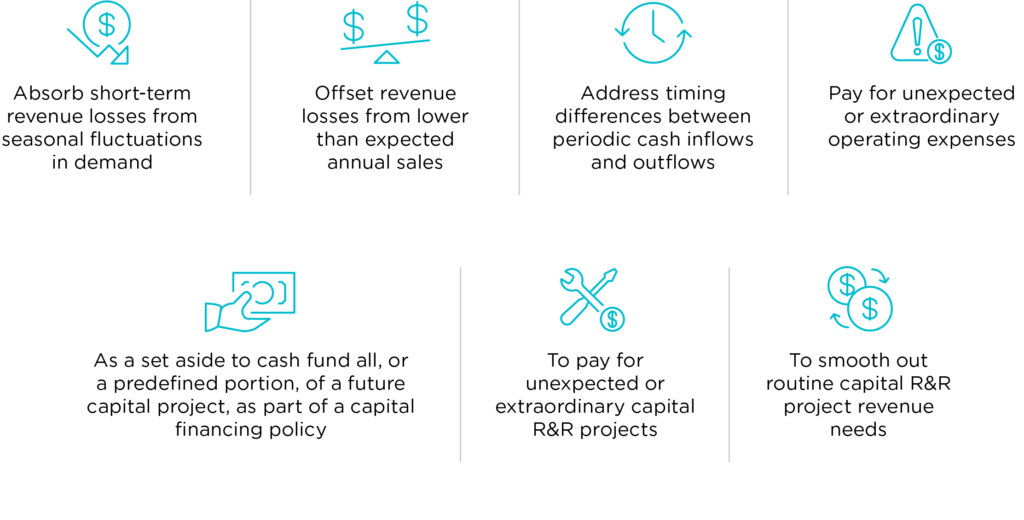

Authors: Phil Sapone and John Mastracchio
There are many fiscal policies that can be implemented by managers striving to ensure a strong financial position for their water and/or wastewater utility. Perhaps none are more important than those pertaining to liquidity needs. Liquidity refers to an entity’s cash position relative to its short-term obligations. At best, a lack of awareness about a utility’s liquidity needs can lead to higher repair and replacement (R&R) costs, rate spikes, and reliance on General Fund support. At worst, it can lead to system failures, long service interruptions, and harmful environmental impacts. Thus, liquidity, or cash reserve policies, play an essential role in helping utilities better serve their customers, while allowing them to operate in a financially stable and self-sufficient manner.
Utility cash reserves are funds set aside, separate from user charges, miscellaneous fees and/or other non-rate or fee-based revenues, governmental transfers, grants, or debt proceeds, that are available to fund the operating and capital-related costs of a water and/or wastewater system. In general, there are three main types of cash reserves: operating, capital, and debt-related.
In this article, we will discuss the purpose of operating and capital cash reserves, their associated benefits, and considerations for how to implement these reserves at levels appropriate for each utility.

While reserves are maintained to address the utility’s liquidity needs, there are other reasons to have reserves in place. Operating cash reserves are commonly held to:
Capital reserves can also serve:
Maintaining adequate cash reserves involves encumbering rate payer funds for non-specific or uncertain events and their associated costs. The utility should be able to realize a clear benefit by holding the reserve.
There are multiple benefits that can be realized by maintaining sufficient operating and capital reserves. As reserves address liquidity needs, one benefit is that they ensure bills are paid on time and in full, and the utility can continue to operate without interruption. Reserves also support utilities in their operation as self-sustaining enterprises independent from general governmental support. Without the help of cash reserves to supplement system revenues at certain times, utilities might require general governmental support to meet their obligations. In addition, reserves can help eliminate or mitigate rate spikes in response to unexpected operating expenses or higher than normal routine R&R costs, allowing customers to enjoy the benefit of relatively stable and predictable bills on a year-to-year basis.
Capital reserves can also be used to commence work on urgent R&R projects with minimal lead time. The utility will incur fewer service interruptions to customers, avoid possible adverse environmental impacts, and minimize further damage to the system or to nearby public infrastructure, as problems within the system can be addressed in a more timely manner. When capital reserves are established in response to debt management policies, they can help to reduce the need for new debt, decreasing interest and other finance-related costs. The utility can also reduce the administrative burden associated with new debt issuances when cash is used to fully fund capital project costs.
Lastly, reserves can serve to reduce borrowing costs by maintaining strong, or improving weaker, credit ratings. Bond rating agencies such as Fitch Ratings, Moody’s Investor Services, or Standard and Poor’s Financial Services consider various factors in developing their credit ratings; however, a utility’s financial strength remains a key aspect of a strong rating and agencies view adequate reserve levels favorably as part of their ratings criteria.
No special formula exists to determine the level of reserves a utility should carry and there is no “one size fits all” amount. The appropriate level of minimum operating and capital reserves that should be maintained varies from utility to utility, and several factors should be carefully considered in determining these amounts. In addition, it should be noted that minimum reserve levels can be stated in dollar terms, as a specific dollar amount, or they can be expressed as the number of days cash on-hand. In general, days cash on-hand is understood to represent unrestricted and available cash on-hand, divided by annual operating expenses, multiplied by 365 days per year.
Factors to consider when determining the minimum level of operating cash reserves include, but may not be limited to:
According to the Fitch 2018 Medians, for utilities with an “AAA” rating, the median level of reserves was 692 days cash on hand, for “AA” rated utilities, the median level was 572 days, while for “A” rated utilities, the median was 311 days.[1] These figures include both operating and capital reserves. While comparing a utility’s cash reserves to these medians may be useful, as discussed above, there are many factors that should be considered in establishing cash reserve levels and targeting a median industry value may not be appropriate considering a utility’s specific circumstances.
The main factor to consider when determining an appropriate minimum target for a capital reserve is the intended use of the reserve. For example, if the utility wishes to establish a capital reserve as part of a fiscal policy related to debt management, the size of the reserve will depend on the policy for cash funding, the number of years until the asset is to be acquired, and the estimated cost of the capital asset or assets to be acquired. Alternatively, if the reserve is being established to address unexpected capital R&R costs, utility managers should consider the replacement value of assets that could be at risk of failure based on their knowledge of the system’s overall condition, or historical cost of unexpected capital R&R expenditures in prior fiscal years. Another option to assess possible R&R reserve levels is to review the fixed asset register, estimate the replacement value of assets that have reached the end of their depreciable, or industry-accepted, service lives, and compare that amount to the R&R spending from current revenues.
When the purpose of the capital reserve is to mitigate rate spikes by smoothing out revenue needs associated with routine capital R&R, contributions to the reserve may be made based on the estimated average annual routine R&R capital need and the actual amount spent in a given year. For example, if the average annual routine R&R capital spend over a 10, 15, or 20-year time horizon is estimated to be $5 million per year and the utility spends $3 million in a given year, then $2 million should be deposited into the capital reserve in that year. Of course, in years where the actual cash funding requirement for these projects exceeds the annual estimate, a withdrawal will be made from the reserve to offset the revenue need and, as a result, mitigate required rate increases.
In conclusion, understanding the utility’s liquidity needs and implementing a cash reserve policy is an important step that utility managers can take to operate their water and/or wastewater systems in a more fiscally responsible manner. Operating and capital reserves are two types of reserves commonly used by utilities to address their liquidity needs. While establishing policies and implementing these reserves in response to utility needs is a rather simple and straightforward process, the benefits associated with operating and capital reserves are significant, and in the end, will better allow the utility to meet its most important goal, which is the provision of safe, reliable, and sustainable service to its customers.
[1] 2018 Water and Sewer Medians, Fitch Ratings, Inc.